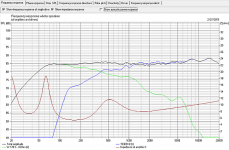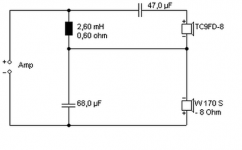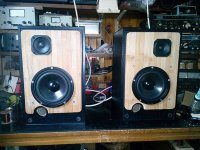Interesting points. Minimum phase filters are often said to sound more natural or musical than their linear phase equivalents. It's always pointed out the the ringing of the min phase filter is after the spike rather than before it, but it's usually not pointed out that the ringing is also of a higher amplitude. I have no problem personally with properly implemented linear phase filters. I also like a tight impulse response where ringing is both short in duration and low in amplitude (much easier to achieve when using a combination of these two filter types).
The uneven response could be the reason behind the DDR observed.
VERY unlikely, There are huge swaths of musical information missing with the VIFAs. If it was FR it would still be there but at different levels.
The missing information is way down (30-40 dB?) down from what the FR is telling us about
dave
Wesayso, others,
This term "DDR" has never been used by anyone technical to describe what they are subjectively hearing. There are plenty of terms that all of us understand that could be used to describe the sound of a driver based on objective measurements. D'Appollitto even wrote papers (just google D'appolito and testing loudspeakers) explaining how to interpret measurements. Never does he use "DDR."
It is just a term for those that want to continue to claim an air of superiority, while attempting to mislead the blind. It's the classic "I hear it and you cannot measure it" argument.
This term "DDR" has never been used by anyone technical to describe what they are subjectively hearing. There are plenty of terms that all of us understand that could be used to describe the sound of a driver based on objective measurements. D'Appollitto even wrote papers (just google D'appolito and testing loudspeakers) explaining how to interpret measurements. Never does he use "DDR."
It is just a term for those that want to continue to claim an air of superiority, while attempting to mislead the blind. It's the classic "I hear it and you cannot measure it" argument.
VERY unlikely, There are huge swaths of musical information missing with the VIFAs. If it was FR it would still be there but at different levels.
The missing information is way down (30-40 dB?) down from what the FR is telling us about
dave
So you rather keep on arguing about it? The explanation I gave above is just one of the possibilities of the perceived DDR.
I'll tell you that I heard quite different things out of my Vifa's when they were roughly EQ-ed and later on using FIR filters. The rough EQ actually was a lot of fun to listen to! But do decide: do you want to dispel some of these guesses on DDR?
What have we,
Frequency response
Distortion
Ringing
Decay
We could probably think of a few tests to rule out the different factors if we do it one by one. Or we can just keep on arguing about it and telling each other how wrong they are. What's the sense in that?
Either we do something about it or we stop arguing 😀.
VERY unlikely, There are huge swaths of musical information missing with the VIFAs. If it was FR it would still be there but at different levels.
The missing information is way down (30-40 dB?) down from what the FR is telling us about
dave
Huge swaths of missing info? Please show some quantifiable evidence of this missing info. Otherwise it's your unquantifiable opinion vs hard evidence that would say otherwise.
So we keep on arguing? Are we reading only half of the posts here to look for an argument or willing to do some tests...
To quote myself:
Now why are we arguing about that Vifa again?
To quote myself:
There you go...
An example what we could do to learn a thing or two:
Take that driver (A7.3) and use FIR filters on it to remove (as best as we can) the ringing. Test it against the same driver without correction.
In theory the corrected speaker should sound better as it is closer to the input. If it (the corrected speaker) wins the test we have learned the ringing isn't the cause of the enhanced DDR experience.
If the uncorrected speaker wins we have an indication that ringing could be responsible for the enhanced DDR.
If it's a draw between both speakers we move on to the next variable.
The uneven response could be the reason behind the DDR observed. It would emphasise some parts of the music and obscuring other parts. No driver with flat response would be guilty of that.
But there could be other factors at play, like distortion or ringing. But as I said, without a bit of work it remains just a guessing game. 🙁
Again: a simple test could tell us a lot more than this battle of words will ever do.
Now why are we arguing about that Vifa again?
Last edited:
There you go...
An example what we could do to learn a thing or two:
Take that driver (A7.3) and use FIR filters on it to remove (as best as we can) the ringing. Test it against the same driver without correction.
Now the only thing we need is a few listeners experienced in uncovering DDR in drivers and some basic FIR filter knowledge. Both available right here on this forum!
Now the big question: Are we really willing enough to learn?
If A7.3 not available, how about testing another way:
Try to create the suspected distortion modes/ringing/decay/EQ digitally, by FIR or other digital filters, and make listening test with high quality headphones.
Maybe that could tell us something about DDR? Or not?
Simple FAST with TC9FD
Just for fun I made a simple FAST. All components are from my attic except Vifas.
25 liters vented box with a round chamber for TC9.
TC9FD FRD and ZMA files are from Zaph measurements.
Simple series crossover with standard values for C and L.
These speakers are not fun, they're really nice sound with my SET amp. I still think, might be my main speakers in the future 😉
No measurements, sorry. Maybe when/if my acquaintance wills.
But from past experience I know that Boxsim is very reliable design speaker software.
Just for fun I made a simple FAST. All components are from my attic except Vifas.
25 liters vented box with a round chamber for TC9.
TC9FD FRD and ZMA files are from Zaph measurements.
Simple series crossover with standard values for C and L.
These speakers are not fun, they're really nice sound with my SET amp. I still think, might be my main speakers in the future 😉
No measurements, sorry. Maybe when/if my acquaintance wills.
But from past experience I know that Boxsim is very reliable design speaker software.
Attachments
RajkoM,
😎 Even you write just for fun, looks great and serious, enjoy.
PS guess i can drop the ZMA FRD files we talked about over XSim thread.
😎 Even you write just for fun, looks great and serious, enjoy.
PS guess i can drop the ZMA FRD files we talked about over XSim thread.
Just for fun I made a simple FAST. All components are from my attic except Vifas.
25 liters vented box with a round chamber for TC9.
TC9FD FRD and ZMA files are from Zaph measurements.
Simple series crossover with standard values for C and L.
These speakers are not fun, they're really nice sound with my SET amp. I still think, might be my main speakers in the future 😉
No measurements, sorry. Maybe when/if my acquaintance wills.
But from past experience I know that Boxsim is very reliable design speaker software.
Very nice. What woofer model is that ? Are you using electrolytic caps or poly-foil caps?
Thanks Byrtt. I admit, I did not expect such a good sound from these speakers. I'd go to make a neater bamboo face on the box.
Yes, I wanted to compare the possible difference with the newer production TC9, in relation to the time when the APH do measurements.
XRK, thanks for your help and suggestions about TC9.
Capacitors that I used are from my drawer. Basically, it is paralleling MKP and MKC capacitors higher values.
BTW, I am not of those who think that all capacitors in the crossover sound identical or good.
Yes, I wanted to compare the possible difference with the newer production TC9, in relation to the time when the APH do measurements.
XRK, thanks for your help and suggestions about TC9.
Capacitors that I used are from my drawer. Basically, it is paralleling MKP and MKC capacitors higher values.
BTW, I am not of those who think that all capacitors in the crossover sound identical or good.
Just for fun I made a simple FAST. All components are from my attic except Vifas.
25 liters vented box with a round chamber for TC9.
TC9FD FRD and ZMA files are from Zaph measurements.
Simple series crossover with standard values for C and L.
These speakers are not fun, they're really nice sound with my SET amp. I still think, might be my main speakers in the future 😉
No measurements, sorry. Maybe when/if my acquaintance wills.
But from past experience I know that Boxsim is very reliable design speaker software.
that looks great.
would you mind to upload the boxsim file and the boxsim model for the tc9fd?
thank you very much!
Boxsim is relatively easy to use, so a quite accurate model of the vifa is very welcome!
Did you measure that data yourself or did you get it elsewhere?
Boxsim is relatively easy to use, so a quite accurate model of the vifa is very welcome!
Did you measure that data yourself or did you get it elsewhere?
thank you very much!
Boxsim is relatively easy to use, so a quite accurate model of the vifa is very welcome!
Did you measure that data yourself or did you get it elsewhere?
You are wellcome.
TC9FD files are from ZaphAudio measurements.
Best diying.
If the customer has to guess what the product performance might be then there's something fundamentally wrong.
Their market is people who walk in to a store, listen to speakers, and walk out with a set of drivers and/or speakers. And sometimes it's not a Fostex they leave with. Might be wrong to you but their customers don't think the same.
- Home
- Loudspeakers
- Full Range
- Vifa TC9FD18-08 best bang for the buck




